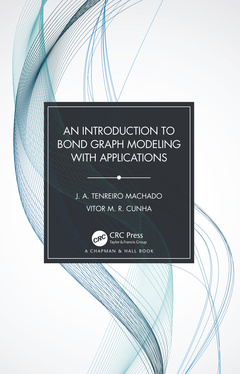Description
An Introduction to Bond Graph Modeling with Applications
Language: English
Subjects for An Introduction to Bond Graph Modeling with Applications:
Keywords
Bond Graph; Dynamical systems; Bond Graph Modeling; MATLAB; Bond Graph Elements; Electromechanical systems; Causal Strokes; Bond graph modeling tool; Bond Graph Representation; Applied mathematics; Rotational Mechanical Systems; Energy Sources; Viscous Friction Coefficients; Translational Mechanical System; Multi-domain System; Hydraulic Resistance; Volume Flow Rate; DC Motor; Causal Conflict; Laplace Domain; Transformation Ratio; Permanent Magnet DC Motor; Ordinary Differential Equations; Electromotive Force; Thermal System; Thermal Resistances; Bond Graph Approach; Signal Flow Graphs; Causality Assignment; Hydraulic System
Publication date: 06-2023
· 15.6x23.4 cm · Paperback
Publication date: 06-2021
· 15.6x23.4 cm · Hardback
Description
/li>Contents
/li>Biography
/li>
An Introduction to Bond Graph Modeling with Applications presents a collection of exercises on dynamical systems, modeling and control for university students in the areas of engineering, physics and applied mathematics. We can find several books on bond graphs, but most merely a small set of exercises and, in a few cases, some commands for computer packages like MATLAB or Mathematica. It is di?cult to ?nd books with a broad set of solved exercises and proposed exercises with solutions, guiding researchers starting their work with bond graphs, or students who are just beginning their study of the topic. This book aims to fill that gap, and provide a comprehensive, reader-friendly introduction to the Bond Graph modeling tool.
Features
- Gives in-depth theoretical background coupled with practical, hands-on instructions.
- Provides a clear pedagogical framework, with numerous exercises and problems.
- Suitable for students and researchers who work with bond graphs: principally such as applied mathematicians, physicist and engineers.
1. Mathematical Models of Dynamical Systems. 1.1. Introduction. 1.2. Modeling of Electrical Systems. 1.3. Transmission Systems. 1.4. Modeling of Hydraulic Systems. 1.5. Modeling of Thermal Systems. 2. Bond Graph Modeling. 2.1 Basic Concepts. 2.2. Bond Graph Elements. 2.4. Examples of Application of Bond Graphs. 2.5. Casualty. 2.6. Assigning Casualty to Bond Graph. 3. Electrical Systems. 3.1. Introduction. 3.2. Solved Problems. 3.3. Proposed Exercises. 4. Mechanical Systems. 4.1. Introduction. 4.2. Solved Problems. 4.3. Proposed Exercises. 5. Hydraulic Systems. 5.1. Introduction. 5.2. Solved Problems. 5.3. Exercises. 6. Thermal Systems. 6.1. Introduction. 6.2. Solved Problems. 6.3. Exercises. 7. Multi-domain Systems. 7.1. Introduction. 7.2. Solved Problems. 7.3. Exercises. 8. Bond Graph Modeling and Simulation Using 20-sim. 8.1 Introduction. 8.2. Guided Exercise. Solutions. Appendices. References. Index.
J. A. Tenreiro Machado was born at 1957. He earned his PhD. (1989) and ‘Habilitation’ (1995), in Electrical and Computer Engineering at the University of Porto. He started his teaching and research activity in 1980. He is currently the Principal Coordinator Professor at the Dept. of Electrical Engineering, Institute of Engineering, Polytechnic Institute of Porto,. His research interests include complex systems, nonlinear dynamics, fractional calculus, modeling, entropy, control, evolutionary computing, and others.
Vitor M. R. Cunha graduated in Electrical and Computer Engineering from the University of Porto in 1999. He completed his master's degree also in Electrical and Computer Engineering from the Polytechnic Institute of Porto in 2009. He started to work as a research assistant after graduating and began teaching at the Dept. of Electrical Engineering, Institute of Engineering, Polytechnic Institute of Porto in 2001. He works in a wide spectrum of subjects such as Information Technology, Virtual Reality, Realtime Simulation, Robotics, Electronics, Modeling and Control of Dynamical Systems.




